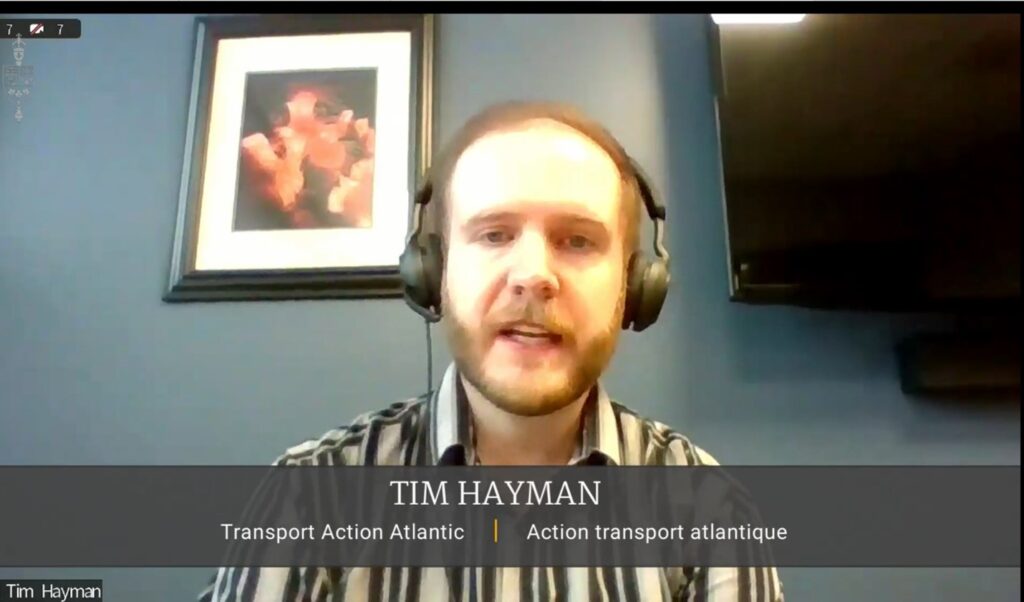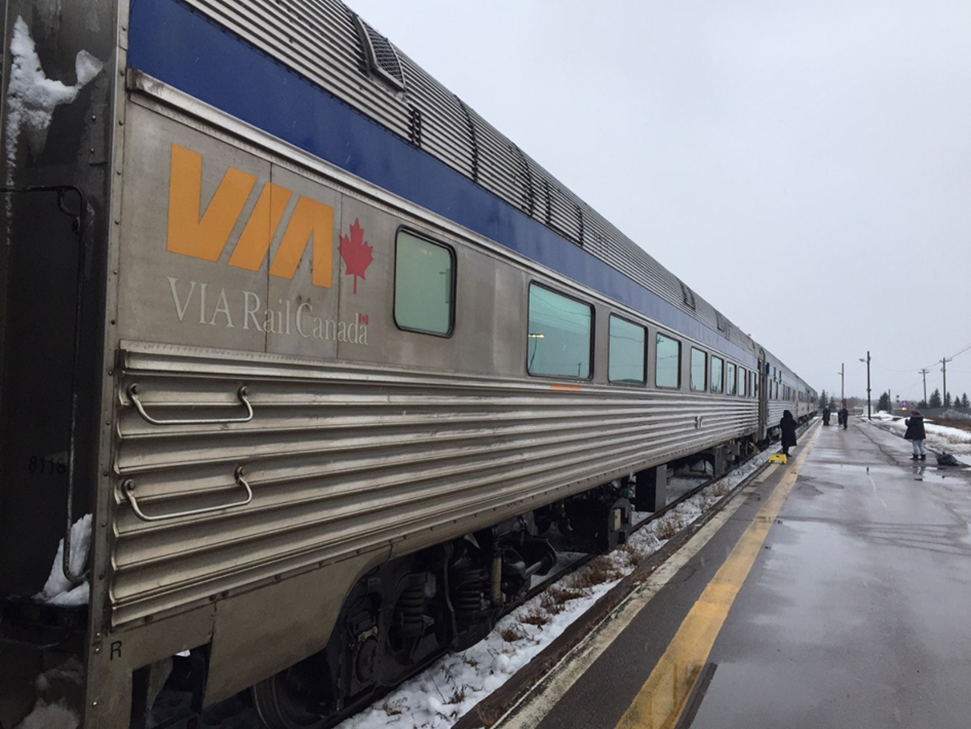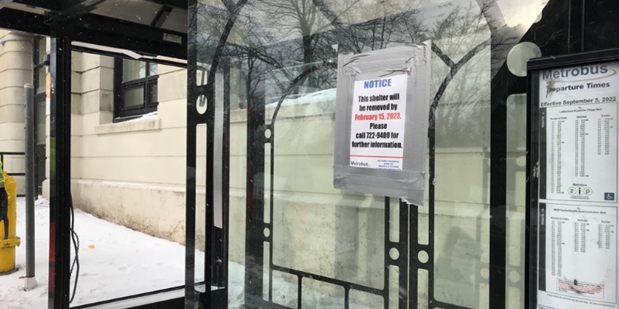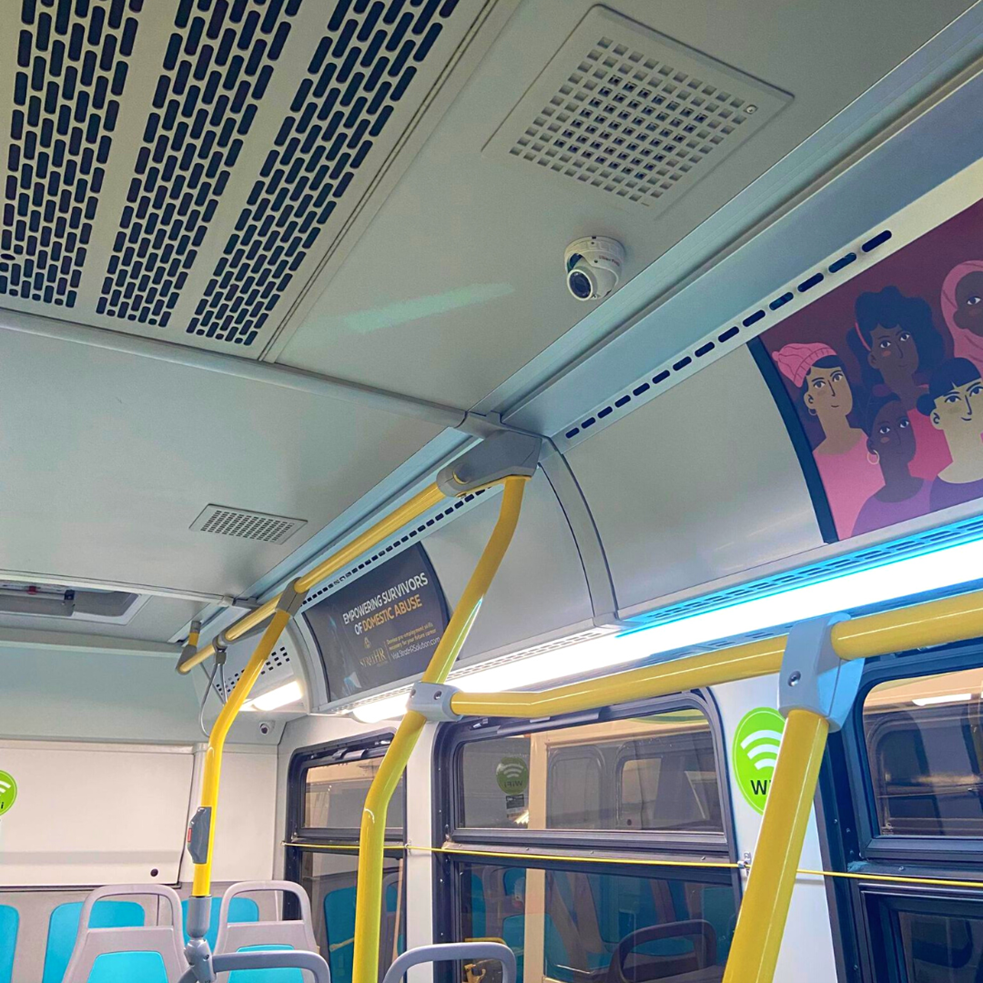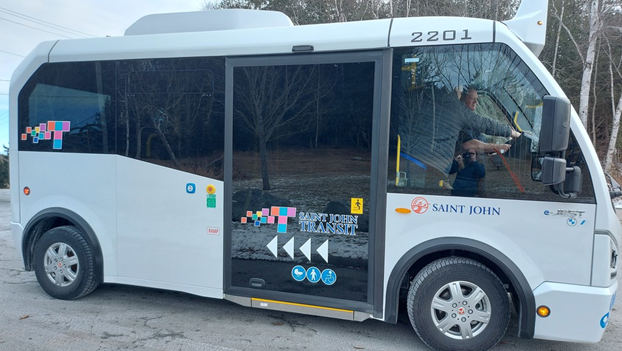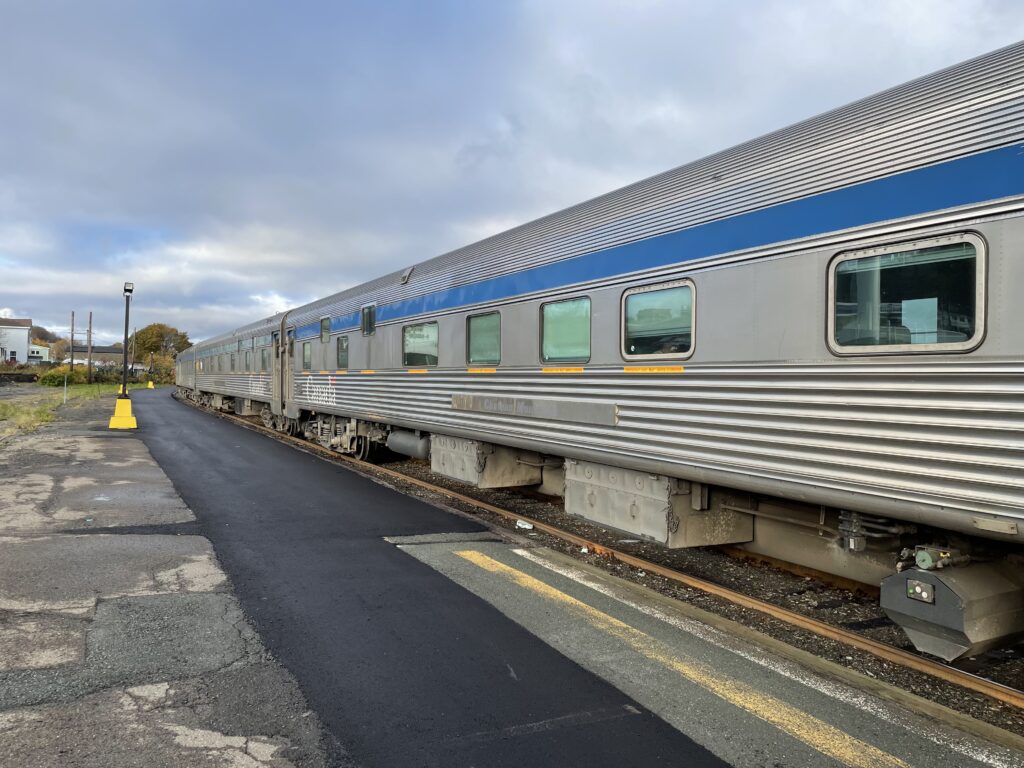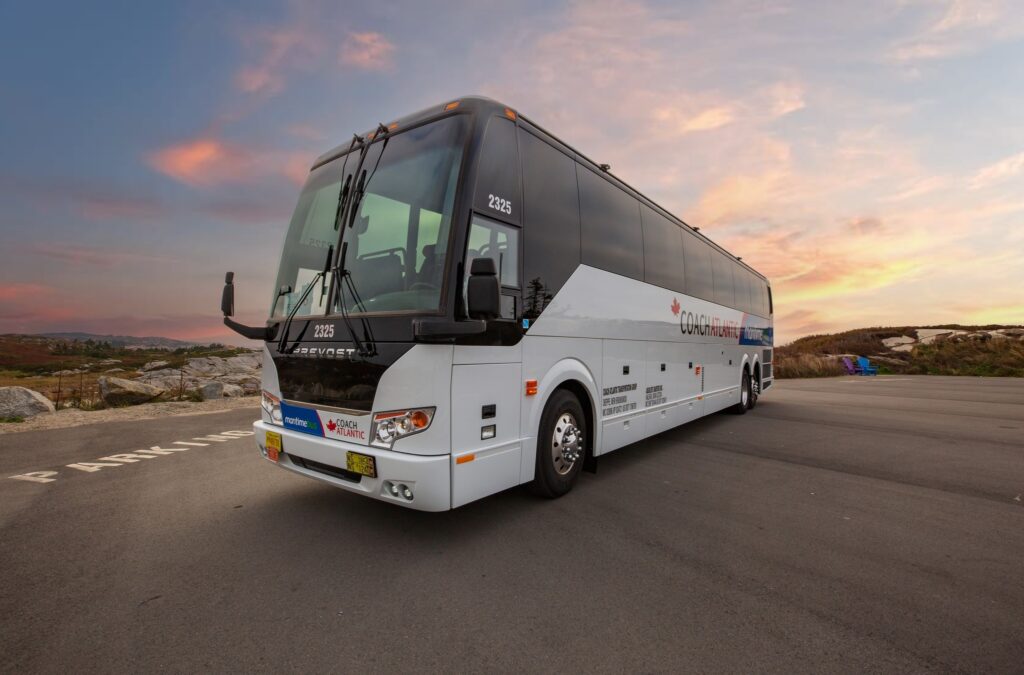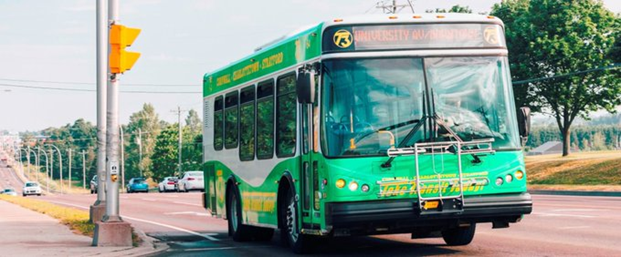Welcome to the March Atlantic Transport News.
Here’s a look at what you’ll find in this edition:
- PEI extends affordable transit pass program
- Electric bus passes with flying colours in Halifax trial
- Nova Scotia faces costly decision on major bridge
- Major highway expenditures in 2023 for NS, NL
- Porter Airlines continues to spread its wings in region
- St. John’s pursuing new overseas flight options
- Iconic cow banished from PEI airport
- Maritime Bus ticket office re-opens in Halifax VIA Rail station
PEI EXTENDS AFFORDABLE TRANSIT PASS PROGRAM

Transit hasn’t been a high-profile discussion item during the current provincial election campaign on Prince Edward Island, but that’s not a cause of concern for public transportation advocates. Apparently it’s really a motherhood issue. Shortly before Premier Dennis King visited the lieutenant governor to initiate the April 3rd vote, his Progressive Conservative government announced another extension to the widely-acclaimed “toonie transit” and discounted pass program – this time for a full year until March 31, 2024. Even if the voters decide not to renew Mr. King’s mandate, it’s considered highly unlikely that any other politician would reverse the popular initiative.
The program is intended to both support the continued growth of public transit and help citizens with the cost of living. The provincial government will provide funding to ensure that transit fares remain the same: $2 adult fare for a single ride and just $20 for a monthly unlimited pass usable on both the island-wide network and the municipal system in the Charlottetown area. The monthly pass is only $10 for seniors and post-secondary students, and all children up to grade 12 ride for free.
“Public transit in Prince Edward Island reached a significant milestone of one million rides in 2022, and we want to keep pace with the growing demand for transit and at the same time, support expansion of the service where gaps have been identified by ridership,” said Transportation and Infrastructure Minister Cory Deagle. “By creating an affordable and reliable Island-wide public transit system, we are reducing transportation barriers for Islanders and helping to create a cleaner, more sustainable province.”
The Island Transit news release reported that as of February 2023, the average number of monthly passes was 1,255, with approximately 9,000 one-way trips for children and students k-12 occurring each month. Meanwhile, ridership on Charlottetown’s T3 Transit is currently up a whopping 55% from pre-pandemic levels.
A new year-round route connecting the North Rustico area to Charlottetown will begin this spring. The Province is currently working with operator Coach Atlantic to determine schedules. This new route is additional to the summer public transit service supporting tourism operations and employees, which will resume by June 19. Last year’s summer service saw an average of 97 daily one-way trips over the months of July and August.
Additionally, the Province is working with the Capital Area Transit Coordinating Committee (CATCC) to expand transit in Charlottetown, Cornwall and Stratford with new routes, added evening services, and extended weekend hours on some of the most popular routes.
ELECTRIC BUS PASSES WITH FLYING COLOURS IN HALIFAX TRIAL
Other cities are following the lead
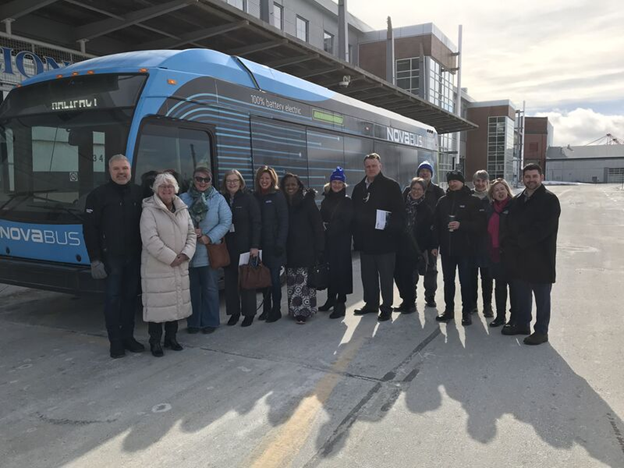
A new era in public transit for the Halifax Regional Municipality is less than a year away, with the first deliveries from an order of 60 all-electric buses expected before the end of this year. All of the vehicles should be ready for service by spring 2024, and officials are pleased at the outcome of an extensive testing program just completed under real-world conditions. A Nova LFSe+ demonstrator bus was put through its paces under winter conditions in February.
“Testing was designed to cover a representative spectrum of typical driving conditions in revenue service, including varied terrain, traffic, weather, and gross vehicle weight,” says Halifax Transit’s executive director Dave Reage. “Results of that testing indicated no significant concerns with respect to performance or range, even in low temperatures or snow conditions.”
He says the new battery powered buses will be added to the current fleet based out of the Ragged Lake Transit Centre facility. An RFP for construction of four new lanes and installation of charging equipment for the Ragged Lake Transit Centre facility has been released, and construction is expected to begin very soon. Upon completion of the new extension, electric buses are expected to be in revenue service by spring 2024.
Councillor Waye Mason wasn’t shy about his enthusiasm for the new vehicles. “What a game changer,” he tweeted after taking a demonstration ride. “For folks inside the bus, no shake, rattle and roll, just a gentle whine as it climbed Duke Street from a dead stop. Plenty of power. Outside the bus, no gut-grabbing bassy rumble as the bus goes by, and no dark cloud of diesel particulates. And, of course, far less GHGs…This is a good future for us!”
Other cities in the region are looking towards a greener transit future as well, but aren’t nearly as far down the road as Halifax. In St. John’s, funding was announced on March 1 for a $200,000 feasibility study to look at electrifying the city’s Metrobus fleet. The City and the federal government are sharing the cost of the research, which will include a risk assessment, cost and saving analysis and identifying infrastructure requirements.
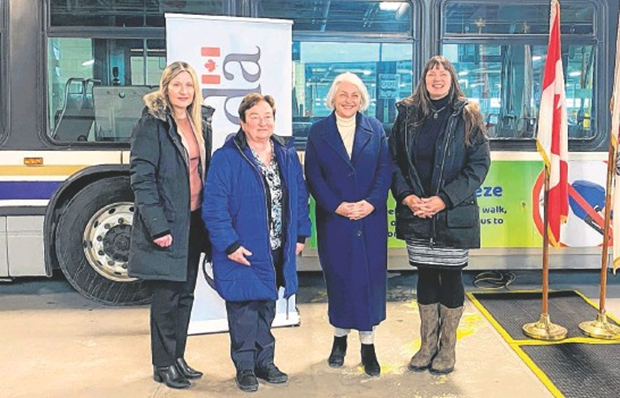
St. John’s East MP Joanne Thompson was on hand for the announcement, describing the study as a “critical first step” and a “significant milestone to reduce the city’s greenhouse gas emissions.”
Deputy Mayor Sheilagh O’leary told the Telegram that while there is no set timeline for when residents can expect to see electric buses in St. John’s, the project is a priority for the city.
“Lots of times in our province, we are often a little bit late to the game, but I think our population has been a bit of a challenge in many respects,” she said. “We know the importance of this energy efficiency, how important it is. Forty-nine per cent of our carbon emissions are coming from transportation. It has to happen and the time is now.”
The study, which is slated to be completed by June, is funded through the federal Zero Emission Transit Fund and is being completed by the Canadian Urban Transit Research and Innovation Consortium (CUTRIC), a non-profit organization designated by the federal government as the designated national planning service for the fund.
Meanwhile in Moncton, City Council has just approved the purchase of four new diesel buses for the Codiac Transpo fleet, at a total estimated cost of $2.6 million. Approximately 40 percent of the expenditure will be federal infrastructure funding.
Planning for conversion to electric vehicles is underway at the transit agency, but the urgent need to replace four obsolete gasoline-powered buses that were well past their best-before date meant that the investment in diesel technology was unavoidable. A presentation to Council pointed out that the new low-floor vehicles will be 31 percent more fuel-efficient than the ones they are replacing, are compliant with the latest emission standards, offer much lower maintenance costs.
Codiac Transpo told the Times & Transcript that the planning and research currently underway is intended to assist the agency in making the best choices on such issues as battery size, charging technology, and the timing of the transition to an electric fleet.
NOVA SCOTIA FACES COSTLY DECISIONS ON MAJOR BRIDGE

Anyone who’s ever driven the Trans-Canada Highway through Cape Breton can’t help but be impressed with the majestic Seal Island Bridge. The massive 716-metre long steel and concrete structure spans the Great Bras d’Or Channel between Kelly’s Mountain and Boularderie Island. It’s a critical piece of transportation infrastructure, not only for the Sydney area but also for the ferry service to Newfoundland. And now, the bridge is showing its age, and the time is fast approaching where some difficult – and potentially expensive – decisions will need to be made.
CBC News has reported that the Province of Nova Scotia is now looking at options to extend its life and plan for its future replacement. When completed in 1961, construction cost was nearly $4.7 million, not including major approach roads. A replacement would doubtless be many times that, but the Public Works Department hasn’t yet begun to crunch those numbers. Two decades ago, a three-year project just to fully replace the deteriorated deck came in at over $15 million. So whatever solution is ultimately decided, it won’t come cheap.
A casual observer will notice evidence of some cracked concrete and corroded metal, but Will Crocker, structures asset management engineer with Nova Scotia Public Works, says such symptoms are common on a bridge of that age. He told the CBC he’s quite confident that it is still perfectly safe. “I wouldn’t hesitate to travel across the bridge,” he said.
He acknowledged, hoswever, that recent reports and inspections show the superstructure and concrete piers are deteriorating. A full inspection of the bridge by engineering consultants in 2018-19 rated the various components in accordance with national standards, and identified areas needing attention.
“As long as those requirements or defects are identified in a timely manner, which they have been, and are repaired in a timely manner, which is what we’re planning to do for this upcoming season, then there will be no problems,” Mr. Crocker said.
For the longer term, Public Works is currently awaiting a cost-benefit analysis from engineering firm COWI, the company that designed and planned replacement of the decking on the Angus L. MacDonald Bridge in Halifax, otherwise known as “The Big Lift.” The firm did its own inspection and added electronic monitors on the bridge’s structure. COWI’s report is expected to offer recommendations on extending the life of the bridge and eventually replacing it. “At some point in the future, the bridge will have to be replaced, says Don Maillet, executive director of highway design and construction with Public Works. “How that’s going to be done and how much remedial work will be required is all part of the cost-benefit analysis.”
MAJOR HIGHWAY EXPENDITURES IN 2023 FOR NS, NL

Four twinning projects on three of Nova Scotia’s major highways will be the main contributors to an expenditure of about $450 million on road work in fiscal 2023-2024. Meanwhile, the Province has already committed an additional $583 million for six new major highway projects, to be constructed between 2025 and 2030.
“This is one of the largest highway infrastructure investments to date,” said Public Works Minister Kim Masland. “This investment will not only make our highways and bridges safer, it will also enable the road-building industry time to plan and prepare for these major investments.”
Among Nova Scotia’s larger projects are:
- Highway 103, Argyle Interchange (Exit 32 and 32A)
- Highway 103, twinning between Exit 6 (Hubbards) and Exit 7 (East River)
- Highway 103, twinning between Exit 7 (East River) and Exit 8 (Chester)
- Highway 104, twinning between Taylors Road and Paqtnkek (Antigonish County)
- Highway 107, twinning from Burnside to west of Loon Lake (Halifax Regional Municipality)
- Tancook ferry infrastructure development (Lunenburg County)
Meanwhile, Newfoundland and Labrador has also announced what Transportation and Infrastructure Minister Elvis Loveless terms an “unprecedented” expenditure on highway construction this year, totalling $225 million. The emphasis will be on upgrading infrastructure vulnerable to the effects of climate change, the minister told CBC News, adding he was anticipating further announcements pending additional funding from the federal government.
“We believe it’s going to be a good year for the paving industry, contractors, workers,” he told reporters during an announcement in St. John’s.
In the past, politicians have come under fire for favouring districts represented by the governing party, but Minister Loveless insists politics has been removed from the process of deciding where tax dollars are spent.
“We’ve put together a solid, balanced plan for road construction projects throughout the province,” he said. “We’re not looking at it from a lens of districts, but through a lens of the advice from the engineers.”
Funding strategies are also influenced by factors such as traffic volumes, the need to support the tourism industry, commercial transportation and industrial sectors, and input from drivers. The plan also includes roads with lower traffic volumes, but with significant deterioration. Most contracts should be tendered by the end of May. Ministers Masland and Loveless both indicated that plans were being announced early to give the construction industry time to prepare, helping to ensure timely completion of projects.
PORTER AIRLINES CONTINUES TO SPREAD ITS WINGS IN REGION
WestJet reveals yet more route reductions
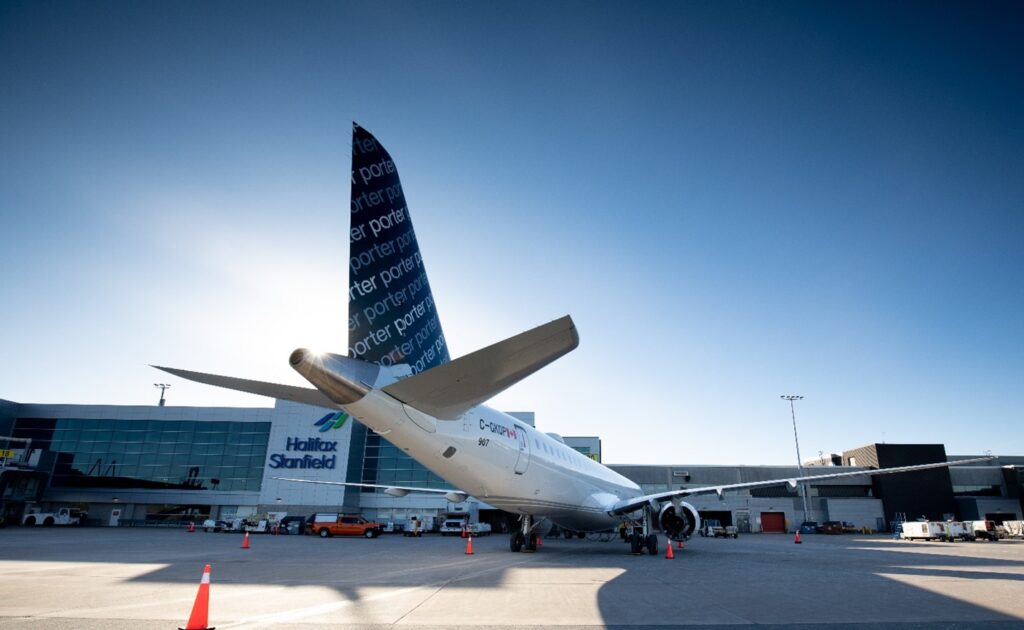
Porter Airlines is continuing to strengthen its footprint in Atlantic Canada, even as WestJet reveals further cutbacks in its service to the region. The latest development as reported by New Brunswick news media is the elimination of WestJet’s Moncton to Toronto service, effective May 1. The route had been reduced to a skeletal tri-weekly operation for the winter months, but until recently the airline was accepting bookings for two flights daily between YQM and YYZ beginning later this spring. That option disappeared from their website in early March, but a WestJet spokesperson said in line with their new western-focused strategic direction they would instead be offering three non-stop flights a week from Moncton to Calgary and two to Edmonton.
Also disappearing indefinitely from the WestJet route map is service between Halifax and St. John’s, which had been suspended for the winter months. Likewise, until recently bookings were being accepted for the resumption of two flights daily between YYT and YHZ beginning in early April. But St. John’s was recently delisted as a destination out of Halifax on their website, and a WestJet spokesperson confirmed to TAA that the YYT-YHZ route will not be returning to their network as part of future schedules. There will continue to be a direct daily flight between St. John’s and Toronto, with connections to other destinations, as well as non-stop seasonal flights to Edmonton and Calgary on varying schedules.
For its part, Porter Airlines is clearly in growth mode, and appears intent on claiming the traffic that WestJet has abandoned. Public affairs director Brad Cicero tells TAA they will operate four daily flights between Halifax and Toronto this summer – two to Pearson using their new Embraer E195-E2 jets, and two to the downtown Billy Bishop Airport with their familiar Q-400 turboprops. There will also be three Q-400 flights daily to both Ottawa and St. John’s, and two to Montreal. Moncton and Fredericton will each have one daily direct flight to both Ottawa and Billy Bishop. And, as announced last month, Porter will inaugurate service to Charlottetown this year, with two daily non-stop Q-400 flights to Ottawa, from where connections may be made to other destinations.
Mr. Cicero confirmed that direct St. John’s to Pearson has been identified as a potential future route as the airline takes delivery of more of the new jets. They expect to have 30 of the Embraer planes in their fleet by year-end, with firm orders placed for 20 more and options for an additional 50. He said, however, there are no plans at this time to introduce jet service between Halifax and St. John’s. The Porter spokesperson, who’s been with the airline since its earliest days, told TAA that they have a very high level of confidence in their growth-oriented business plan. He added that they have been much less impacted by pandemic-related staffing issues than other carriers, even though they were shut down entirely for more than a year. This may in part be related to the age profile of their workforce, with fewer furloughed employees choosing to retire permanently, and a higher proportion returning to active duty when service resumed. Porter currently has about a thousand more employees than it did in 2019.
ST. JOHN’S PURSUING NEW OVERSEAS FLIGHT OPTIONS
Provincial government involved in talks with Aer Lingus
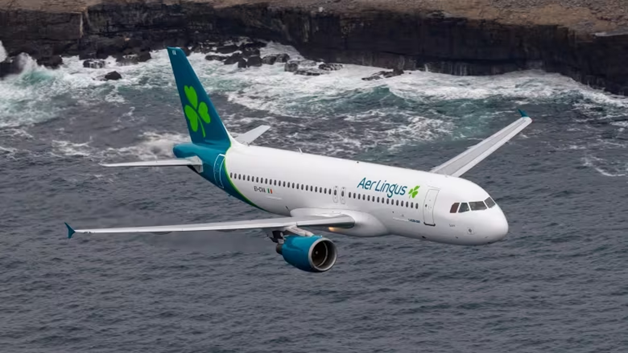
It’s been four years since St. John’s International Airport hosted direct scheduled passenger flights across the North Atlantic – and the local business community, the airport authority and the provincial government have all but given up on Canadian carriers. WestJet has clearly withdrawn entirely from any overseas flying out of Atlantic Canada, and Air Canada has said it has no plans to resume the direct flight from YYT to London Heathrow that was abandoned during the Boeing 737 MAX safety groundings in 2019. Now the Government of Newfoundland and Labrador government has stepped into the picture, and is actively pursuing the potential of reconnecting air links with Europe.
One of the first pitches was to Irish flag carrier Aer Lingus. Premier Andrew Furey and Tourism Minister Steve Crocker met with the airline’s director of network planning in last fall to discuss prospects for a Dublin-to-St. John’s route. Eastbound flying time between the two airports is less than five hours.
“Obviously the re-establishment of a European route is extremely important to us, re-establishment of a direct U.S. route is important to us, as is regional connectivity,” Minister Crocker told CBC News.
He said government has an important role to play, but acknowledged that it’s a tough time as the industry emerges from a COVID-19-related slump. “The thing we hear consistently from airlines when we talk to them is they’re trying themselves – as we are as a province – to get back to pre-pandemic numbers. Their first priority is to get back to their routes that they had pre-pandemic.”
ICONIC COW BANISHED FROM CHARLOTTETOWN AIRPORT

A long-familiar sight in the arrivals area at Charlottetown has been banished from the premises. The iconic cow statue – trademark of the equally-iconic Cows ice cream company – had been the subject of many a photo-op over the past 10 years. But, alas, no more!
Wowie, as she is affectionately known, was unceremoniously loaded on a truck earlier this month, en route to a new and as yet undisclosed home.
Charlottetown Airport Authority CEO Doug Newson told CBC News the cow had to go to make room for renovations.
“This project, which will provide a refreshing new look to the arrivals area, combined with our capacity constraints in the peak the summer months, unfortunately meant that it was time for the cow to be relocated from YYG,” he said.
Cows marketing director Mary Beth Malone said Wowie’s departure has caused an outpouring of affection on social media.
“People from all around the world were sharing their memories of how Wowie at the airport was when they realized that they were on Prince Edward Island, and all the great memories that they had seeing her there,” she said.
Wowie has been taken back to the Cows Creamery store, while company officials figure out a new permanent home for her, Malone told the CBC.
“It’s almost like the end of an era … and it’s nice to hear that she has had such a positive impact.”
MARITIME BUS RETURNS TO VIA STATION IN HALIFAX
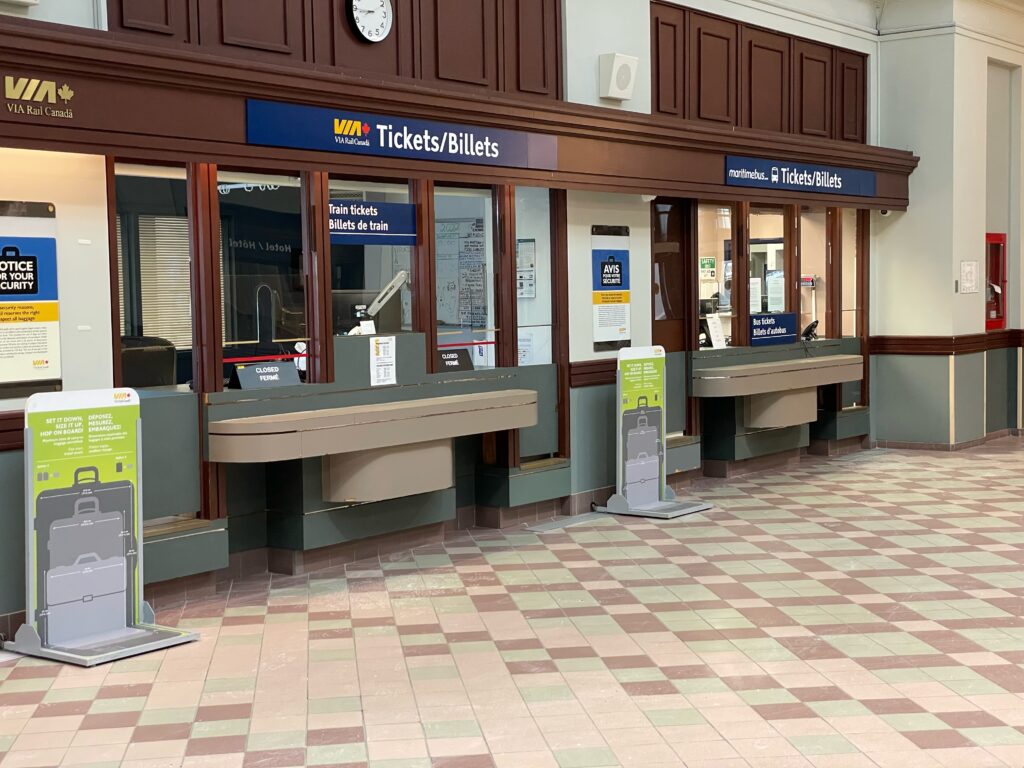
The Maritime Bus ticket office has returned to the inside of the VIA Rail station in downtown Halifax. Several years ago, the office inside the station was closed and passengers buying or picking up tickets had to use the counter in the parcel room, tucked away in a rather unappealing part of the terminal. Bus passengers could still access the waiting room in the station, but then had no convenient way to access ticket agents from the waiting area.
Early in 2023, the former ticket office inside the station next to the VIA Rail counter was reopened, providing a welcome sight. Though the intermodal arrangements between the two transportation providers have faltered in recent years, having another location with both ground transport options readily available is a benefit to those travelling on either mode. A ticket agent on duty at the beginning of March reported that it was nice to be back in the much more pleasant environment, and no doubt passengers will feel similarly!






